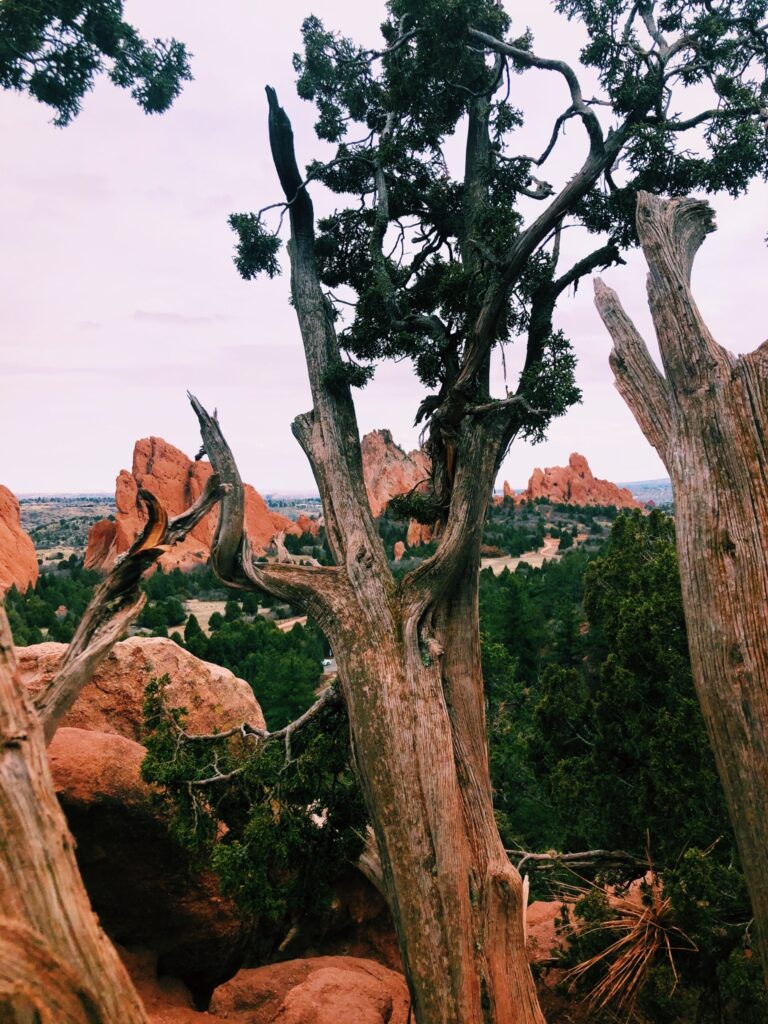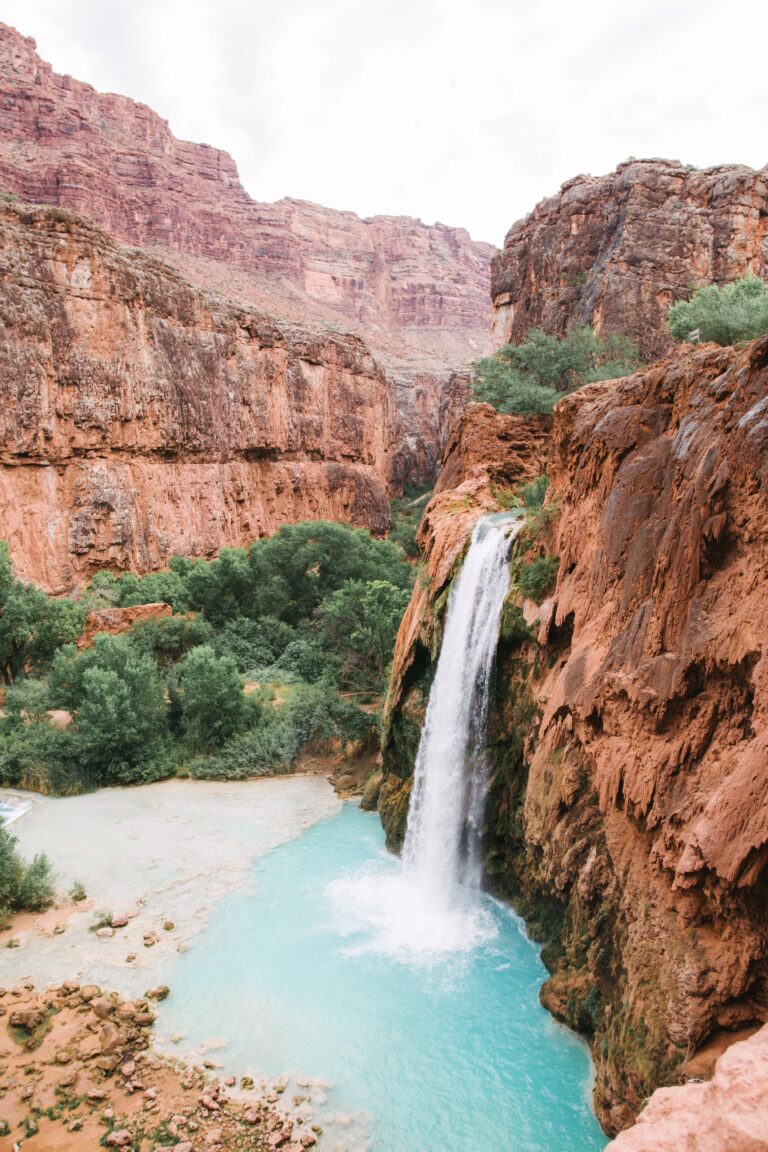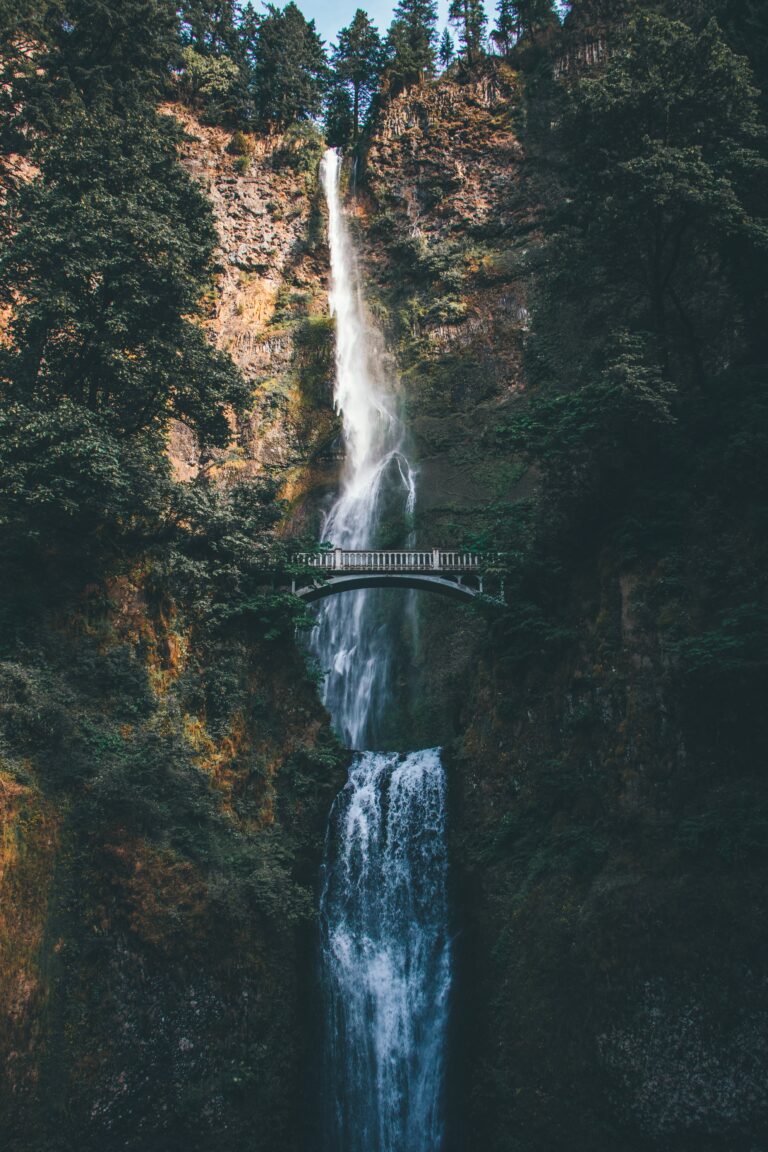14 Gorgeous Mountains in Alaska You Can’t Miss
Looking for the most beautiful mountains in Alaska? These 14+ peaks can’t be missed!
Alaska is a place of unparalleled natural beauty, with its rugged coastline, vast glaciers, and towering mountains. The state’s mountain ranges are some of the most impressive in the world, offering breathtaking views and endless opportunities for outdoor adventure. Whether you’re an experienced mountaineer or a casual hiker, Alaska’s mountains have something for everyone.
In this post, we’ll take a closer look at some of the best mountains in Alaska to visit. From the towering peaks of Denali National Park to the stunning vistas of the Chugach Mountains, we’ll explore the unique features and attractions of each range. We’ll also provide tips and recommendations for planning your trip, including the best times to visit, where to stay, and what to bring. So if you’re ready to experience the majesty of Alaska’s mountains, read on to discover some of the best places to visit in this incredible state.
14. Mount Roberts

At 3,819 feet, Mount Roberts is the first mountain on our list of the best mountains in Alaska to visit. Rising behind the state capital, Juneau, this mountain offers stunning views of the town, the Gastineau Channel, and the Chilkat Mountains in the distance. While it takes about four hours to hike to the top, visitors can take a more straightforward route by riding the Mount Roberts Tramway, which drifts 1,800 feet in just five minutes.
At the top, visitors can explore the interpretation center and take in the breathtaking views. The Timberline Restaurant offers fresh Alaskan meals and craft beers for those looking to refuel. Additionally, there are hiking trails on top of the mountain that are perfect for gentler walks through temperate rainforests and alpine meadows filled with colorful flowers.
As you explore, keep your eyes open for the local wildlife, including black bears, bald eagles, and whistling marmots. For a more comprehensive experience, consider taking the Juneau City Sightseeing and Mendenhall Glacier Tour, which allows visitors to learn about the area’s past and present while seeing the beauty of Mendenhall Glacier, which flows from the 1,500-square-mile Juneau Ice field.
This tour can accommodate up to nine people and includes a complimentary meal. With so much to see and do, Mount Roberts and the surrounding area offer a truly unforgettable Alaskan experience.
13. Mount Alyeska
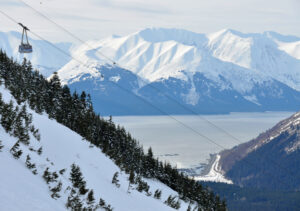
Alyeska is a year-round destination that offers something for everyone. In the winter, it’s a fabulous ski resort, while in the summer, it’s a great place to hike and ride mountain bikes. With a height of 3,939 feet, Alyeska is part of the Chugach range and is located just 40 minutes from Anchorage. To get there, take the Seward Highway south from Anchorage for about 36 miles, and turn right at Girdwood to follow the directions to Alyeska resort. As you turn right, you’ll be greeted by the sight of beautiful Mount Alyeska and its ski runs.
To truly experience the mountain’s beauty, take a ride on the Alyeska Tramway, which takes you up 2,300 feet in just seven minutes. From there, you can see seven hanging glaciers that look like vast rivers of ice flowing over the surrounding mountains. Keep your eyes open for bears and moose in the forest below. At the top, the AAA Four-Diamond Seven Glaciers Restaurant serves high-end Alaskan seafood, but be sure to make a reservation ahead of time for this feast.
For those seeking adventure, Alyeska’s Bike Park offers mountain biking trails for all skill levels, from easy rides through flower-filled pastures to hair-raising dirt trails down the mountain. If hiking is more your style, the North Face Trail is a 2.2-mile advanced trail that begins immediately at the hotel and goes uphill. Some of the best parts of this classic ski terrain are the roads and single-track trails with switchbacks that climb the 2,000-foot vertical slope.
When you arrive at the top, you can use the aerial tram for free to get back down. So whether you’re a winter sports enthusiast or a summer adventurer, Alyeska is the perfect destination for your next Alaskan getaway.
12. Mount Wrangell

The next mountain on our list is a massive shield volcano that offers incredible views and endless outdoor activities. Mount Wrangell is among Alaska’s most significant landforms, rising 14,163 feet and holding about 220 cubic miles of particles. The area around the summit has a deep hole filled with ice over 3,000 feet deep, and the massif looks more like a range of mountains than a single peak.
While scientists keep an eye on Wrangell for occasional seismological rumblings or steam clouds, the last big eruption may have been as long as 80,000 years ago. From the Glennallen region, this giant soars in a picture-perfect way, providing stunning views from the last 10 miles of driving east into Glennallen on the Glenn Highway. Wrangell is located around 180 miles northeast of Anchorage, south of Drum and Sanford, a prominent ridge with smaller peaks.
For even more breathtaking views of Mount Wrangell, head to the Richardson Highway and Wrangell-St. Elias National Park Visitor Center. If you want to see the mountain from the air, nearby Wrangell Mountain Air has been specializing in Alaska flights and expedition tours since 1992. Take advantage of daily scheduled flights between McCarthy and Chitina, fly-in day package tours that include guided glacier hiking, or tours of the iconic Kennecott mill building. There is also a charter air taxi facility to many Alaska towns and world-class flightseeing.
For those seeking adventure, rafting, glacier trekking, wilderness camping, fly-in hiking, and backpacking trips are all viable options that we highly recommend as a day or multi-day adventure. With so much to see and do, Mount Wrangell is a must-visit destination for anyone looking to experience the natural beauty and outdoor adventure of Alaska.
11. Mount Hunter

Mount Hunter, also known as Begguya, is a majestic mountain located in Alaska’s Denali National Park, just eight miles south of Denali. As the third-largest peak in the Alaska Range, Hunter is more demanding to climb than Denali, despite being lower in elevation. Its steeper slopes and more corniced peaks make it a challenging climb, and it receives far fewer visitors than its significantly larger neighbor.
Few people attempt to climb Mount Hunter because it is the most difficult 14,000-foot mountain in North America, and less than 40% of those who try tend to succeed. Climbing to the top north peak requires endurance, bravery, and persistence, as well as the ability to navigate its complex peak coated by a large ice sheet plateau.
The mountain’s challenging terrain begins at its icy base, where the 44-mile-long Kahiltna Glacier, the lengthiest glacier in the Alaska Range, serves as a campsite for many mountain climbing trips in the area. In recent years, Mount Hunter has received more attention for its difficult and beautiful climbing on its walls and ridges. All of the ascents on this mountain are physically and technically challenging because they are a mix of rock, ice, and snow climbing.
One of the most famous routes up Mount Hunter is the West Ridge, which is a great classic but also a route with observable dangers that can be lessened but not removed. In particular, there’s an area by seracs that guard the route’s entry, which can be geological hazards. Anyone who wants to climb Hunter should be conscious of these risks and take appropriate precautions.
Despite the challenges, Mount Hunter offers a unique and rewarding climbing experience for those who are up for the challenge. With its stunning views and difficult terrain, it’s no wonder that it has become a sought-after destination for experienced climbers seeking a true test of their skills.
10. Mount Bear

Mount Bear is a mountain that you can’t miss. It has a couple of glaciers on its side, which makes a trip here a magical experience.
Mount Bear is an elevated, glaciated peak in Alaska’s Saint Elias Mountains that rises 14,831 feet. It is 4 miles west of the Yukon boundary, in Wrangell-Saint Elias National Park.
The Barnard Glacier comes down from the mountain’s southwest side, while the Klutlan Glacier comes down from the north. It is one of the 20 highest mountains in the United States.
Even though Mount Bear is high, it is not a famous summit because it is surrounded by higher and better-known peaks, like Mount Bona.
Even compared to other mountains, it’s a prominent peak. For example, the drop from the pinnacle to the Barnard Glacier is 8,000 feet in less than 5 miles & 10,000 feet in less than 12 miles.
To climb Mount Bear, you must know how to use crampons and an ice axe on modest snow.
Like any good Alaska trip, the day starts with a bush plane ride. Your plane, with skis, takes you and your group from McCarthy to the East Fork of the hill. From there, it will take you days to get to the top.
Also, Mt. Bear is the perfect ski mountaineering peak because it has 8,000 feet of almost continuous skiing from the top. You can have the best skiing experience here, accompanied by views of Mt. Logan, Mt. Bona, and Mt. Churchill.
You can also go to McCarthy, the city closest to this mountain. It’s hard to say what’s the best thing to do here, but you’ll get to see the Alaskan landscape and explore local places. To help you decide, you can check McCarthy Museum or do some ice climbing.
9. Mount Hubbard

Mount Hubbard is among the Saint Elias Range’s most famous peaks. It is on the boundary of Alaska and Yukon. Kluane National Park and Reserve occupy the Canadian side, and Wrangell–St. Elias National Park lies on the American side.
Mount Hubbard, the seventh-tallest mountain in the United States, rises to a height of 14,951 feet and is known for its vast rise above the surrounding landscape.
The west side of Mount Hubbard is hard to climb because the cliffs drop off very sharply. Here, technical climbing skills are needed. On the other hand, there is a non-technical way to get to the top of Mount Hubbard’s eastern side.
But climbing the mountain can be challenging since it is 25 miles from Disenchantment Bay, which makes the weather somewhat unpredictable.
You can also enjoy this towering peak by looking at it from a good vantage point by taking a flight or going on a boat trip. Many companies offer these trips where you can see the beautiful Hubbard Glacier apart from Mount Hubbard.
The Hubbard Glacier is North America’s biggest tidewater glacier. It has a length of 76 miles, is 7 miles wide, and is 600 feet tall at its end face. What makes it so unique? This glacier moves and recedes like no other glacier. As a tidewater glacier, it grows and shrinks due to the shape of its end.
Of course, you can take advantage of what Wrangell–St. Elias National Park has to offer where this mountain is. Exploring the backcountry is one of our favorite things to do and is something we recommend.
Most of the park is in the backcountry, and more than 10 million acres are set aside as wilderness. You can also go on rafting trips or go hiking.
8. Mount Fairweather
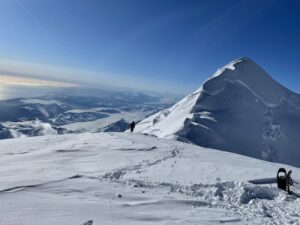
Mount Fairweather is a colossal mountain that sits on the boundary between Alaska and Yukon. It is the 18th tallest mountain in North America. And it is in Glacier Bay National Park and Preserve and has a height of more than 15,000 feet.
Fairweather is in the Saint Elias Mountains and part of the Fairweather Range. It is right above Glacier Bay and among the most northern point in the Panhandle of Alaska.
Like many other pinnacles in the St. Elias Mountains, Mount Fairweather’s steep climb from Glacier Bay gives it a lot of vertical relief. Due to the harsh weather, however, the peak is often hidden by clouds. Most people who try to climb the mountain fail because of the bad weather.
Today, planes can land at an altitude of roughly 9,000 feet close to the Grand Plateau Glacier. If you get lucky and encounter a settled high-pressure cell, you can climb up the West Ridge reasonably quickly. But many purists might think this is too high to start.
Fairweather is still climbable from sea level in a couple of weeks, so flying to high camp takes away the chance to have an exceptional sea-to-summit experience. With the peak’s height and terrible weather, climbing is a big deal no matter where the ascent starts. Only a few groups try it each year.
Also, climbing this mountain is one of many ways to enjoy it. Thanks to endless outdoor activities, you can have fun going to the nearby small town of Haines.
Further, you can explore the 3.3 million-acre Glacier Bay National Park and Preserve’s coastal beaches with protected coves, deep fjords, tidewater glaciers, and freshwater lakes. It is one of the world’s most beautiful natural places!
7. Mount Sanford

Backcountry explorers and mountaineers love this one.
The 16,237-foot Sanford is the sixth-highest mountain in Alaska. It is in the northwest corner of the Wrangell Mountains, roughly 200 miles northeast of Anchorage and 40 miles east of Glennallen.
Volcanologists know little about Sanford’s geology because its summit is always in snow and ice. From the north, a ridge rises to the summit; from the south, a 7,200-foot cliff forms a spectacular amphitheater, making the shape of the mountain even more enjoyable.
More so, Mount Sanford is a shield volcano throughout the Wrangell Volcanic Field near the Copper River in eastern Alaska. It is the third-tallest volcano and the sixth-highest mountain in the US.
At the head of the Sanford Glacier, the volcano’s south face rises 8,000 feet in a mile, making it one of North America’s steepest slopes. Scientists think that Sanford hasn’t erupted in thousands of years.
If you are near Glennallen, get your cameras ready.
About 180 miles northeast of Anchorage, on the last 10 miles of the drive east into Glennallen on the Glenn Highway, a great view of Sanford and its sister volcanoes, Drum and Wrangell, fills the windshield. You can pull over in this area. And the Tok Cutoff Highway toward Gakona and Chistochina will give you different views of this massive peak.
You can see more views at the Wrangell-St. Elias National Park guest center is at Mile 106.8 of Richardson Highway, roughly 10 miles south of where the Richardson and Glenn highways meet.
Join a guided expedition to climb Sandford easily, where you can expect a mix of backcountry adventures and mountaineering. After landing on a glacier, you’ll start your two-week-long climb to the top. This mountaineering trip in Alaska promises to be a once-in-a-lifetime experience!
6. Mount Blackburn

Mount Blackburn, a height of 16,390 feet, should also be on your list of mountains to visit. After all, it is the highest peak and most impressive massif in Alaska’s Wrangell Mountains.
It is the fifth-highest peak in the country and the twelfth-highest in North America, boasting some of the most fantastic views in the world.
There are two peaks on Mount Blackburn. It wasn’t famous that the mountain’s highest point was the West Peak until the 1960s when new surveys and more precise USGS maps were made available. Climbers were able to ascend it on May 30, 1958.
East Blackburn, also called Kennedy Peak, was first climbed in 1912 using Kennicott Glacier and the East Face. Miners carved a path up the broken East Face by crossing deep ravines and rifts in the ice. It was a great adventure that was way forward of its time.
On a clear day, the unpaved road to McCarthy offers a beautiful view of this enormous mountain. Another great way to see this peak is from the air by taking flightseeing trips.
Now, you should be in good shape if you want to climb this sky-high mountain. It is a challenging climb, and only a small number of people can reach the top.
But if you participate in an expedition guide, this arduous Alaskan trip will be easier to finish.
Mount Blackburn Expedition includes transportation, places to stay, scenic bush flights, professional guides, food, and group gear. In this at least 12 days expedition, you’ll climb more than 16,000 feet over 14 miles.
However, the mountain has some of the most severe weather because it is close to the Gulf of Alaska. But if you finish your trip, it will surely be worth it.
5. Mount Bona

Mount Bona is the fifth-highest individual peak in the United States. It is also among the most important summits in the Saint Elias Mountains in eastern Alaska.
Further, Bona is the tallest volcano in the United States. A small cone-shaped volcano rises at the top of a high platform of sedimentary rocks.
The Klutlan Glacier gets most of its ice from the mountain’s massif, with snowfields and glacier cover. The existing standard route here is the East Ridge. The first ascent happened in 1930.
You can enjoy this peak in many ways. Popular activities include tours and climbing. This mountain’s itinerary usually lasts almost two weeks, so you must be in good shape.
Also, the more experience you have climbed before you try to climb Mt. Bona, the safer and more comfortable you will be, and the more likely you will reach the top.
So, if you want to do something in the state that you’ll never forget, Mount Bona it is! One of the best parts of your trip will be reaching the top of one of Alaska’s tallest mountains. Besides that, you can think while looking at the fantastic views of the peaks around you.
Also, get your ski gear ready because skiing is another popular activity in this mountain region. Do you want to go camping? You’re in luck because there are also many places to camp. It will enable you to take it easy and enjoy the Alaskan wilderness.
On the other hand, flightseeing is available to several companies near the mountain. With it, you can observe this magnificent peak from above and from any angle.
If you feel cold, don’t forget to warm up with a hot drink from the surrounding restaurants.
4. Mount Foraker

Mount Foraker’s funny thing is that if you’ve seen Denali from a distance, you’ve probably also seen Mount Foraker.
From Anchorage, it looks about as tall as Denali but is 3,000 feet shorter. Foraker is a 17,400-foot mountain in Denali National Park that is 14 miles southwest of the state’s highest peak.
With that, it is the third-highest peak in the US and the sixth tallest in North America.
This peak is also one of the best for flying over the landscape. There are bush plane companies in the area, and round-trip flights usually cost between $400 and $450.
During the flight, the surrounding peaks will be visible. But you better keep your eyes open because Mount Foraker has a variety of plants and animals.
Numerous animals that can endure cold weather or snow live on the mountain. It includes the caribou. It is a type of deer that dwells in cold climates and high latitudes. These animals are native to the Arctic and the mountain ranges of North America.
The moose, or Alces alces, is another type of deer that lives on the mountain and is famous for its colossal size. You can also find Northern Hawk-owls, Grizzly Bears, Arctic Ground Squirrels, Red Squirrels, Willow Ptarmigans, and Arctic Ground Squirrels, among others.
Alternatively, skiing is another option. On your trip, you’ll see incredible vistas. We suggest taking the route from Kalhitna to Foraker.
You can also go hiking, but again, you should come prepared. Climbers face steep steps, wild cornices, and knife-edged ridges on Mount Foraker, which can be very difficult. But it’s worth the effort because you’ll be standing on one of the highest points in the state.
3. Mount Saint Elias

At 18,009 feet, Mount Saint Elias is the second-highest summit in the United States and Canada. It is in the middle of Alaska and the Yukon Territory. The peak is in Wrangell-St. Elias National Park and Preserve on the Alaskan side.
On Saint Elias, the weather is constantly changing, and storms from the Pacific can hit with little warning. A bush plane is the only way to navigate this rough, hard-to-climb mountain.
Mount Saint Elias is far away, steep, and has no rescue services, so only experienced climbers should try to climb it.
This giant is in Wrangell-St. Elias National Park, which is also the country’s largest park. With a vast 13.2 million acres of protected areas, this area will give you plenty of ways to have fun.
Your favorite thing can be driving along McCarthy Road and thinking about how big the mountain is. This 60-mile gravel path used to be a railroad track and goes through beautiful, untouched wilderness. You can see moose, black bears, grizzly bears, swans, owls, eagles, and other animals here.
On the other hand, the 42-mile Nabesna Road on the upper side of the park, which is one of only two roads that lead into the park, has excellent views.
You’ll also see beautiful views, such as Mount Saint Elias. Even though there’s a mine at the end of the road, it’s not open to tourists. This drive focuses more on the trip than the destination.
The amount of land in this mountain and national park is so huge that the only way to get a sense of it is from the air. It’s an incredible experience as you rise above the mountains!
2. Denali

When the fog lifts from Denali, it is the most remarkable of all of Alaska’s mountains.
Denali, which is 20,310 feet tall, used to be called Mt. McKinley. As the tallest mountain in North America and the tallest in Alaska, it dominates the panorama for hundreds of miles.
It is also the world’s third most notable and roughest peak. Since this mountain is so high, it often creates weather. The peak is in Denali National Park, which is bigger than the state of New Hampshire and gets an estimated 400,000 visitors annually.
A flightseeing tour lets you see the “Roof of North America” up close. You are by ridges and peaks in this tour that are all higher than any peak in the Lower 48. These are part of the Alaska Range.
This arc of peaks starts in Denali park and ends at the Pacific Coastal Range, which goes to Central America.
Also, the scenery here is out of this world. There are dangerous-looking cornices on top of ridges, and hanging icecaps the size of shopping centers fall off their sides. Plus, fluted ridges hundreds of feet high ascend near-vertical slopes.
You can also view Denali from a distance by taking advantage of several vantage points.
The Denali Viewpoint South is a famous destination at mile A 134.8 of Parks Highway. It has watching scopes, informational boards, a day-use parking space, and camping areas.
Denali Park Road is an option for a scenic drive. The park road goes right into the middle of Denali National Park, where there are many chances to see the mountain.
You also have the option to hike to this peak. People who want to try high-elevation expedition mountaineering should climb Denali. But you have to be experienced and ready.
1. Alaska Range
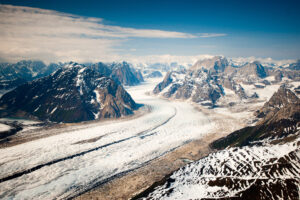
Although not technically a mountain, Alaska Range is one of the mountain ranges you can’t miss.
There are 278 named mountains in the Alaska Range, which is shaped like a crescent moon and stretches over 400 miles through Central Alaska. It is part of the much bigger Pacific Mountain System and is the world’s third-highest range.
The Alaska Range is also one of the most famous mountain ranges in the country because of its rough, massive peaks, notoriously harsh weather, and immense glaciers.
It draws tourists who want to see Alaska’s famous alpine landscapes, world-class alpinists, and brave climbers or mountaineers who want to reach the highest point on seven continents.
From the Aleutian Range in southwestern Alaska to the border of Yukon territory, the Alaska Range generally goes north and east.
Most remarkably, the Alaska Range is known for having the worst mountain climate outside of Antarctica. It is also home to Denali, one of the world’s largest and most famous mountains.
Also, in the Alaska Range, there are a lot of places to see and go. Whether you like to hike or ride a bike, the Alaska Range is a place where you can find hidden gems.
Since this mountain range is lengthy, it is visible from places like Fairbanks and Anchorage. So you can see it while doing several outdoor activities and visiting attractions.
There are, of course, many hiking trails in this mountain range. The Triple Lakes Trail and the Mount Healy Overlook Trail offer scenic views of the Denali wilderness.
Conversely, the Kesugi Ridge Trail is the best way to spend time in the remote Alaskan wilderness while enjoying the beauty of this magnificent mountain range. This region’s weather is volatile and unpredictable. Therefore, a backcountry experience is ideal.
As you noticed, Alaska has a lot of majestic peaks to offer. Whether you want to see them by land, sea, or air, you have many options. Not to mention the countless recreational activities that are all within reach.
Try one of these mountain peaks in your next adventure. You will touch the clouds with these top 14 mountains in Alaska you can’t miss!
